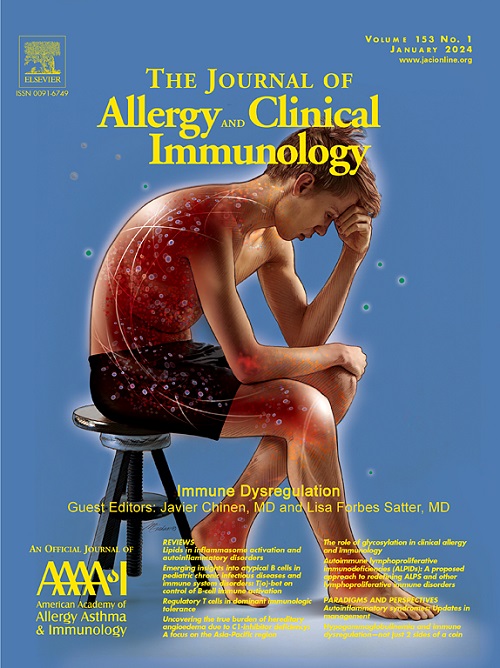Ruxolitinib治疗改善STAT3功能获得性疾病患者的临床、免疫学和转录组畸变
IF 11.4
1区 医学
Q1 ALLERGY
引用次数: 0
摘要
背景:STAT3功能获得性(GOF)疾病表现为淋巴细胞增生、自身免疫和生长失败。虽然JAK抑制剂可以缓解症状,但其对疾病发病机制的影响尚不清楚。目的:前瞻性研究4例长期接受鲁索利替尼治疗的STAT3型GOF患者的临床、免疫学和转录组学反应。方法:我们在基线和ruxolitinib治疗后的3、8、12和超过12个月进行临床和免疫学评估。我们的评估包括循环T滤泡辅助细胞(cTFH)、调节性T细胞(Treg)、细胞因子水平和增殖分析。此外,我们研究了治疗后转录组学的变化,并进行了t细胞受体测序。结果:Ruxolitinib对临床表现的控制效果较好。治疗后评估显示,初始CD4+和CD8+ T细胞群显著增加,同时效应记忆T细胞显著减少。此外,cTFH细胞和双阴性T细胞减少。治疗前已经降低的Treg细胞百分比及其典型标记物,在ruxolitinib治疗后进一步降低。治疗未改变CD4+ T细胞的IFN-γ、IL-17A、IL-10、IL-4细胞因子的产生。重要的是,ruxolitinib有效地使外周血单核细胞中先前失调的转录组谱正常化,使其更接近健康对照。这种正常化在stat3靶向基因、干扰素相关基因、髓细胞活化和细胞毒性效应CD8+ t细胞基因的下调中最为显著,其影响持续长达12个月。基于TCR库分析的自反应性t细胞指数揭示了患者样本中潜在的自反应性细胞克隆。结论:Ruxolitinib逆转了细胞和转录组特征,增强了我们对疾病病理生理的理解,并突出了精确监测的必要免疫标志物。本文章由计算机程序翻译,如有差异,请以英文原文为准。
Ruxolitinib treatment ameliorates clinical, immunologic, and transcriptomic aberrations in patients with STAT3 gain-of-function disease
Background
Signal transducer and activator of transcription 3 (STAT3) gain-of-function (GOF) disease presents with lymphoproliferation, autoimmunity, and failure to thrive. Although Janus kinase inhibitors have alleviated symptoms, their effects on disease pathogenesis remain unclear.
Objective
We prospectively investigated the clinical, immunologic, and transcriptomic responses of 4 patients with STAT3 GOF under long-term ruxolitinib treatment.
Methods
We conducted clinical and immunologic evaluations at baseline and after ruxolitinib treatment at 3, 8, 12, and more than 12 months. Our assessments included measurement of levels of circulating T follicular helper cells, regulatory T cells, and cytokines, as well as proliferation assays. Furthermore, we investigated the transcriptomic changes with treatment and conducted T-cell receptor sequencing.
Results
Ruxolitinib achieved substantial control over the clinical manifestations. Posttreatment evaluations demonstrated a notable increase in naive CD4+ and CD8+ T-cell populations, alongside a significant reduction in effector memory T-cell levels. Additionally, there was a decrease in levels of circulating T follicular helper cells and double-negative T cells. Regulatory T-cell percentages and their canonical markers, which were already reduced before treatment, declined further with ruxolitinib. The treatment did not alter the production of IL-4, IL-17A, IL-10, and IFN-γ cytokines by the CD4+ T cells. Importantly, ruxolitinib effectively normalized the previously dysregulated transcriptome profile in PBMCs, bringing it closer to that of healthy controls. This normalization was most striking in the downregulation of STAT3-targeted genes, interferon-related genes, myeloid cell activation, and cytotoxic effector CD8+ T-cell genes, with effects persisting for up to 12 months. Self-reactive T-cell indices based on T-cell receptor repertoire analysis revealed potential autoreactive cell clones in the patient samples.
Conclusion
Ruxolitinib reversed cellular and transcriptomic signatures, enhancing our understanding of the disease's pathophysiology and highlighting essential immunologic markers for precise monitoring.
求助全文
通过发布文献求助,成功后即可免费获取论文全文。
去求助
来源期刊
CiteScore
25.90
自引率
7.70%
发文量
1302
审稿时长
38 days
期刊介绍:
The Journal of Allergy and Clinical Immunology is a prestigious publication that features groundbreaking research in the fields of Allergy, Asthma, and Immunology. This influential journal publishes high-impact research papers that explore various topics, including asthma, food allergy, allergic rhinitis, atopic dermatitis, primary immune deficiencies, occupational and environmental allergy, and other allergic and immunologic diseases. The articles not only report on clinical trials and mechanistic studies but also provide insights into novel therapies, underlying mechanisms, and important discoveries that contribute to our understanding of these diseases. By sharing this valuable information, the journal aims to enhance the diagnosis and management of patients in the future.

 求助内容:
求助内容: 应助结果提醒方式:
应助结果提醒方式:


